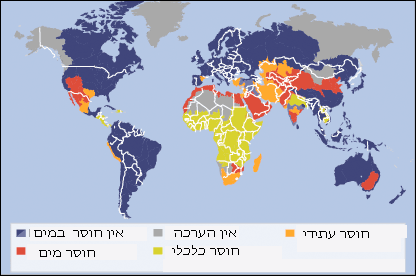"Rich countries must change policies to avoid a situation that exists in poor countries - lack of water". This is according to a report by the World Conservation Organization

In reporting the results of a global survey conducted by the World Conservation Organization WWF, the organization warns that: "Rich countries must change policies to avoid a situation that exists in poor countries - lack of water." The survey conducted in industrialized countries shows that in many of the countries the effort to continue supplying water to the cities is increasing, when governments talk about savings but fail in implementation.
Developed industry and constant growth in the population of "first world" cities are two factors that bring the consumption of water quantities beyond the supply capacity. Water-wasting agricultural processing methods, excess fertilization, runoff from houses and barns - endanger the water reservoirs and pollute them. That is why the authors of the report recommend raising water prices (for industry, agriculture, and personal consumption), a price increase that will require savings.
From Seville in the book through Sacramento in California to Sydney in Australia, water is a central political issue at the levels: local, regional, national and international. In developing countries, the approach is accepted that "the use of water must be efficient and water must be returned to the environment to the extent that it allows the restoration of the natural system." Many countries recognize the need to repair the damage caused to water systems and drainage basins in nature. Applying the recognition to actions requires changing the habits and behavior of stakeholders, which has proven to be a goal that is not easy to achieve.
According to the report: European countries on the shores of the Atlantic Ocean suffer from repeated periods of drought, water reservoirs around the Mediterranean Sea are being depleted due to the tourist "boom" and the development of agricultural areas. In Australia, which is considered the driest continent, salinization of fields is becoming a problem in a large part of the agricultural areas. In the USA, huge areas are irrigated with water quantities above and beyond what nature provides, which means the water reservoirs are being emptied. Even in rainy Japan there is an acute problem of pollution of water sources.
According to the report, the future picture looks bad: considering global warming, followed by increased evaporation and irregular rains, accelerated melting of glaciers and snow, salting of wells due to sea level rise, all of these are already causing a growing water deficit.
In order to face the emerging situation, the authors of the report suggest courses of action: maintaining drainage basins and bodies of water, balancing consumption and conservation, repairing old and wasteful infrastructures, raising water prices for consumers, stopping the pollution of water sources, fundamentally changing access to the resource - water, studying and researching systems the water.
If the situation does not change fundamentally, the world is expected to experience a water shortage that will increase, a shortage that already exists in many countries in the "Third World" will spread to the countries of the "First World" and affect all systems, the world will be more and more thirsty.
